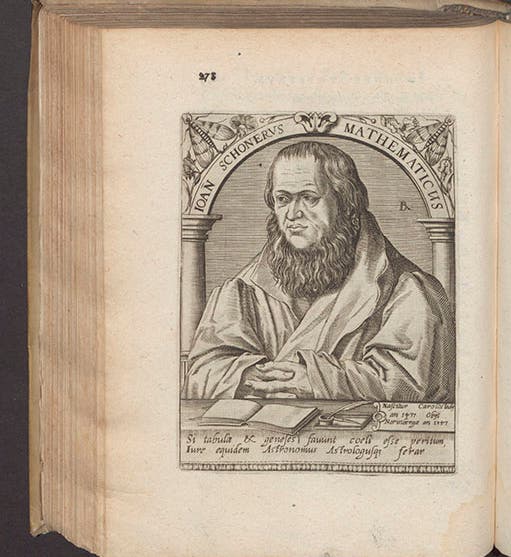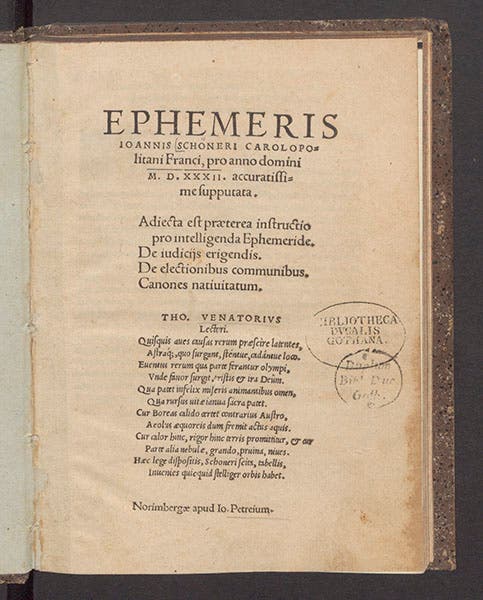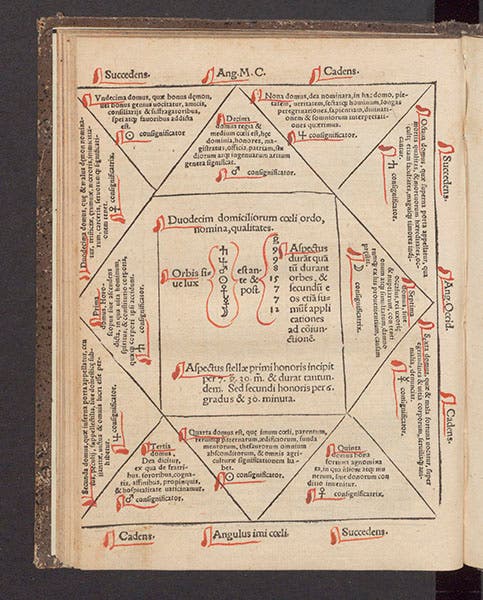Scientist of the Day - Johann Schoner
Johann Schöner, a German mathematician and astronomer, was born Jan. 16, 1477. We celebrated his birthday four years ago, when we discussed his connections with Georg Rheticus, Nicholas Copernicus, and Johannes Petreius (publisher of Copernicus’ milestone book), as well as Schöner’s star globe and its appearance in Hans Holbein’s painting, The Ambassadors (1533). You may read or re-read this earlier post, and view the images (which we will not repeat today), here.
One reason for a second birthday celebration today is to display our second Schöner portrait, which appeared in the Icones quinquaginta virorum illustrium of J.J. Boissard (1597-99), one of the great portrait books of the late Renaissance. In spite of the title, which lays claim to 50 portraits, the work actually has 50 portraits per volume, or 200 in all, including Copernicus, Andreas Vesalius, Conrad Gessner, and dozens of other people we would now call scientists. You can see six portraits from Boissard’s book in our profile of his engraver, Theodore de Bry. A seventh portrait, that of Schöner, opens this post (first image).
The other reason for a renewed discussion of Schöner is to allow us to showcase a second Schöner book in our collection. In addition to Rheticus’s Narrratio prima, Copernicus’s De revolutionibus, and Schöner’s Globi stelliferi – the books we featured in 2015 – we have three other Schöner books in the Library: Opusculum astrologicum (Little book on astrology, 1539), Tabulae astronomicae (Astronomical tables, 1536), and Ephemeris pro anno Domini M.D.XXXII (Almanac for the year 1533, 1531).
Two of these books are astrological, reminding us that, in Renaissance times, astronomy and astrology were different facets of the same science, and every astronomer, including Schöner, observed planets and stars, cast horoscopes for patrons, and compiled almanacs with an astrological basis.
The Ephemeris of 1531 offers us a glimpse of Schöner as astrologer (second image). There are two pages, facing each other, that graphically summarize the complexions, genders, humoral associations, and other attributes of the 12 astrological houses and zodiacal signs. All of the red lines (rubrication) were drawn in by hand by an early owner (third and fourth images).
A table in the Ephemeris provides the positions and rising times of prominent stars, such as Humer. dexter Ori (the star in the right arm of Orion, Betelgeuse), or Cor Leonis (the heart of the lion, Regulus), or Ocul. Tauri (the eye of the bull, Aldebaran) (fifth image). The last column indicates the planets that are astrologically associated with each star.
Another table lists several dozen cities and the time difference between them and Nuremberg (the name of which was printed in all caps, with the time difference 0 0), where Schöner lived and where the book was printed (sixth image).
All three of the Schöner books mentioned here were published by Johannes Petreius, the most respected and most prolific scientific publisher of the mid-16th century. Our copy of Schöner’s Ephemeris was given to us in 1984 by the eminent historian of astronomy, Owen Gingerich.
Dr. William B. Ashworth, Jr., Consultant for the History of Science, Linda Hall Library and Associate Professor emeritus, Department of History, University of Missouri-Kansas City. Comments or corrections are welcome; please direct to ashworthw@umkc.edu.











